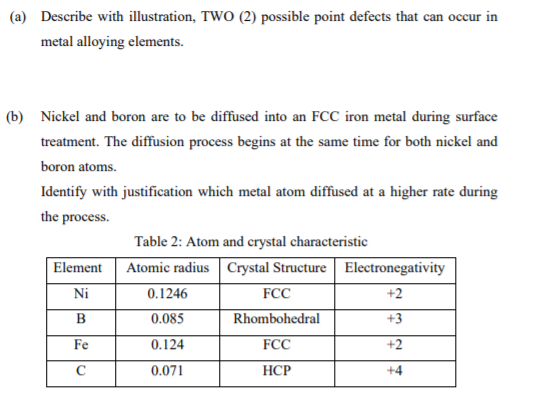(a) Describe with illustration, TWO (2) possible point defects that can occur in metal alloying elements. (b) Nickel and boron are to be diffused into an FCC iron metal during surface treatment. The diffusion process begins at the same time for both nickel and boron atoms. Identify with justification which metal atom diffused at a higher rate during the process. Table 2: Atom and crystal characteristic Element Atomic radius Crystal Structure | Electronegativity Ni 0.1246 FCC +2 B 0.085 Rhombohedral +3 Fe 0.124 FCC +2 0.071 НСР +4
(a) Describe with illustration, TWO (2) possible point defects that can occur in metal alloying elements. (b) Nickel and boron are to be diffused into an FCC iron metal during surface treatment. The diffusion process begins at the same time for both nickel and boron atoms. Identify with justification which metal atom diffused at a higher rate during the process. Table 2: Atom and crystal characteristic Element Atomic radius Crystal Structure | Electronegativity Ni 0.1246 FCC +2 B 0.085 Rhombohedral +3 Fe 0.124 FCC +2 0.071 НСР +4
Elements Of Electromagnetics
7th Edition
ISBN:9780190698614
Author:Sadiku, Matthew N. O.
Publisher:Sadiku, Matthew N. O.
ChapterMA: Math Assessment
Section: Chapter Questions
Problem 1.1MA
Related questions
Question
100%

Transcribed Image Text:(a) Describe with illustration, TWO (2) possible point defects that can occur in
metal alloying elements.
(b) Nickel and boron are to be diffused into an FCC iron metal during surface
treatment. The diffusion process begins at the same time for both nickel and
boron atoms.
Identify with justification which metal atom diffused at a higher rate during
the process.
Table 2: Atom and crystal characteristic
Atomic radius Crystal Structure Electronegativity
Element
Ni
0.1246
FCC
+2
0.085
Rhombohedral
+3
Fe
0.124
FCC
+2
C
0.071
НСР
+4
Expert Solution
This question has been solved!
Explore an expertly crafted, step-by-step solution for a thorough understanding of key concepts.
Step by step
Solved in 3 steps with 3 images

Knowledge Booster
Learn more about
Need a deep-dive on the concept behind this application? Look no further. Learn more about this topic, mechanical-engineering and related others by exploring similar questions and additional content below.Recommended textbooks for you

Elements Of Electromagnetics
Mechanical Engineering
ISBN:
9780190698614
Author:
Sadiku, Matthew N. O.
Publisher:
Oxford University Press

Mechanics of Materials (10th Edition)
Mechanical Engineering
ISBN:
9780134319650
Author:
Russell C. Hibbeler
Publisher:
PEARSON

Thermodynamics: An Engineering Approach
Mechanical Engineering
ISBN:
9781259822674
Author:
Yunus A. Cengel Dr., Michael A. Boles
Publisher:
McGraw-Hill Education

Elements Of Electromagnetics
Mechanical Engineering
ISBN:
9780190698614
Author:
Sadiku, Matthew N. O.
Publisher:
Oxford University Press

Mechanics of Materials (10th Edition)
Mechanical Engineering
ISBN:
9780134319650
Author:
Russell C. Hibbeler
Publisher:
PEARSON

Thermodynamics: An Engineering Approach
Mechanical Engineering
ISBN:
9781259822674
Author:
Yunus A. Cengel Dr., Michael A. Boles
Publisher:
McGraw-Hill Education

Control Systems Engineering
Mechanical Engineering
ISBN:
9781118170519
Author:
Norman S. Nise
Publisher:
WILEY

Mechanics of Materials (MindTap Course List)
Mechanical Engineering
ISBN:
9781337093347
Author:
Barry J. Goodno, James M. Gere
Publisher:
Cengage Learning

Engineering Mechanics: Statics
Mechanical Engineering
ISBN:
9781118807330
Author:
James L. Meriam, L. G. Kraige, J. N. Bolton
Publisher:
WILEY